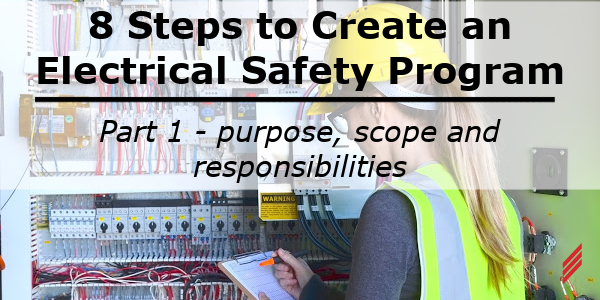8 Steps to Create an Electrical Safety Program Part 1
by Jason Mazzola on Oct 5, 2021 10:30:00 AM

My Name is Jason Mazzola. I am an Electrical Engineer and prior to coming to Hallam-ICS I spent 10 years in the Utility industry in various leadership roles. Mostly I was in charge of Engineering and Operation and Maintenance groups. During my time in the Utility industry I built strong technical and safety minded foundations and witnessed firsthand the importance of putting safety above all else. I was also involved in many incident investigations and bring with me the knowledge of those events when analyzing safe electrical work practices.
I’m a Qualified Electrical Safety Trainer and my team and I have completed over 2500 arc flash assessments. Over the course of my career I have seen improvements in the understanding of electrical safety in all areas; PPE, training, work practices and system improvements. Helping organizations understand and adhere to the regulations set forth by OSHA is our team’s top priority. This is the first of a five-part blog series and by the end of this series, I hope you will have learned the key components for creating a low voltage Electrical Safety Program based around NFPA 70E. Your safety program is the backbone of a safe work environment and is a vitally important document for those who work with electricity to follow.
Part 1: Purpose, Scope and Responsibilities
Part 2: Requirements and Protective Measures
Part 3: Required Safe Work Practices
Part 4: Required Safe Work Practices Continued
As a refresher for those of you who are familiar or provide a quick overview for those who are new to Electrical Safety Programs, having an Electrical Safety Program is necessary to be in compliance with regulatory agencies. The Occupational Safety and Health Administration (OSHA) is an entity that is enforceable as law. OSHA 1910.333, .335 mandates that all employers, regardless of industry, provide electrical safety in the workplace for all employees and contractors. Whereas OSHA states the law, the National Fire Protection Association’s (NFPA) guideline NFPA 70E demonstrates how an electrically safe working environment is implemented.
Most facilities have maintenance staff or on-site electricians who, at times, may need to perform work on live electrical equipment. The result is that your qualified staff needs to perform live electrical work. If they are not properly trained on the hazards of construction and operation of the equipment, these people could experience a shock or arc flash. The electrical safety plan is your first line of defense against these types of incidents and addresses how to evaluate the risks and the lays out the safe work practices your staff should be adhering to. Failure to establish these parameters may result in an incident occurring. The repercussions can be quite substantial including costs associated with medical bills, damaged equipment, lost production, fines, insurance claims, lawsuits and the most important, the possible death of one of your employees.
Purpose
The first component to include in your safety document is the purpose of the Electrical Safety Program; it is to provide basic safety requirements for your staff who work on or near electrical apparatus. It is important to remember that this document is the minimum requirement for your staff. Those folks who are working with or around electrical systems should understand and follow the requirements outlined in your written Electrical Safety Program. It is important when creating the purpose to clearly define who the intended audience is. This section basically serves as an introduction and overview for the document.
Scope
The next section to include is a scope. This will state that the document is to be followed by anyone preforming electrical work. Electrical work is defined as any work that requires direct or indirect contact or interaction with electrical equipment. A few examples of this would be racking a circuit breaker in or out, working on or inspecting an electrical panel, or work inside of a Motor Control Center. 
It is important to define that this document is intended to be followed when working on low voltage only, low voltage is anything below 600V. This document is not intended to be a guideline for voltages over 600v; this would require a separate document that addresses the specific requirements for working with the higher voltages. My recommendation is that best practice is to establish that NO energized electrical work will be performed. This will greatly decrease the chances of having an electrical incident and keep your staff as safe as possible.
There are a few exemptions to this rule as laid out by NFPA 70E and those should be considered. The first is if an Energized Electrical work permit is used. The permit would have to be authorized and signed by local management. There are also some tasks that are exempt and not considered live work including testing, troubleshooting, voltage measuring, thermography, visual inspection, and written site-specific work practices that have been reviewed and approved by management. These exemptions should be included in your safety plan and clearly laid out.
Responsibilities
Responsibilities is the next section to include. In this section of your plan you need to establish the responsibilities of Management and Persons which covers Qualified Persons, Unqualified Persons, Escorts, and any Contractors that may work for or with you. It is good to note in this section that the Utility company and all subsidiaries are exempt from your plan, they are governed by a different set of standards.
Management’s responsibilities should include but are not limited to, the dissemination of the program, they should also review the program every three years and add or remove content as needed. Supervisors are responsible for the safety of all persons under their direction and must also follow and enforce local safety plans. Supervisors generally are the closest management employee to the work being done so they need to remain vigilant in their enforcement efforts.
Qualified Persons are the folks that you deem have the knowledge and experience to do the work electrical work at your site. This needs to be demonstrated to you and only you can deem them qualified. With being considered qualified there are certain responsibilities they have and they should be outlined in the plan. For example, they are responsible for keeping unqualified persons out of the limited, restricted, and arc flash boundaries. They are responsible for following proper work procedures and proper use of tools and they should remain up to date on the rules and specifications of their job.
Escorts need to be qualified and are responsible for the safety and compliance of the folks in their care.
Unqualified Persons need to be aware of electrical hazards even if their work doesn’t involve direct interaction with electrical equipment. They are also not permitted to be inside the limited or arc flash boundaries as outlined in NFPA 70E. A basic electrical hazard awareness training would be suited nicely for these folks. It would make them aware of the hazards but doesn’t need to be as detailed as your qualified persons training.
Finally, Contractors are responsible for following their own up to date safety plan and if they do not have one, they should be adopting yours for the duration of their work. On a side note when you bring contactors in, you should be asking if they have a plan in place and I would obtain a copy to have on record.
This has been Part 1 of my 5-part series that I have put together to help give your ESP shape. If you have any questions please forward them to me at jmazzola@hallam-ics.com. Myself or someone on my team will be happy to help.
About the author
Jason Mazzola is the Director of Electrical Safety Services for Southern New England out of our Mansfield, MA office. He joined Hallam-ICS in 2019 and prior to that spent 10 years in utility industry in various engineering and leadership roles.
About Hallam-ICS
Hallam-ICS is an engineering and automation company that designs MEP systems for facilities and plants, engineers control and automation solutions, and ensures safety and regulatory compliance through arc flash studies, commissioning, and validation. Our offices are located in Massachusetts, Connecticut, New York, Vermont and North Carolina and our projects take us world-wide.
You May Also Like
These Related Stories

Culturally Different… Does Hallam-ICS really use the word “love” as a Shared Value?

Blind Spot Animal Sanctuary: Emus, Alpacas, Goats, Pigs, and More!



Comments (1)